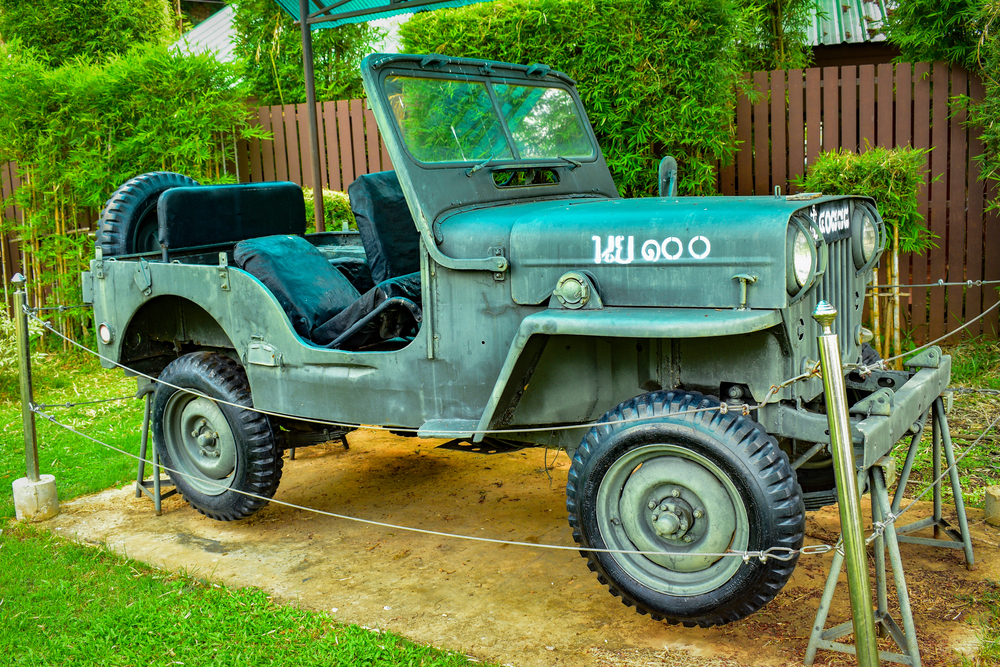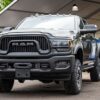Military jeeps have long been symbols of strength, reliability, and innovation in off-road vehicles. Designed for rugged terrains and unpredictable conditions, these iconic vehicles played essential roles in military operations, transporting troops, supplies, and equipment across battlefields and remote locations. Their durability and performance made them invaluable assets in both World War II and later conflicts, and they quickly became admired not only by soldiers but also by civilians who saw their capabilities in action. Military vehicle enthusiasts continue to appreciate these machines’ historical importance and the engineering feats that allowed them to withstand the toughest conditions.
Contents
Dodge WC Series

The Dodge WC Series, produced between 1941 and 1945, is beloved for its versatility and durability. These vehicles were used extensively during World War II in various configurations, from troop carriers to ambulances. Their rugged design and robust four-wheel drive made them ideal for transporting soldiers and supplies across rough terrain, cementing their reputation as tough and reliable. Many enthusiasts admire the WC Series for its adaptability in military settings, as well as its historical significance in supporting the war effort. Today, the WC Series is valued by collectors who appreciate its strong build and rich legacy.
Toyota Land Cruiser BJ

The Toyota Land Cruiser BJ, first introduced in 1951, marked Japan’s entry into military off-road vehicles. This model’s ability to traverse Japan’s most challenging landscapes, including scaling Mount Fuji, earned it global recognition. Its design, inspired by American jeeps, combined reliability with rugged off-road performance, making it an essential tool for Japan’s military and public safety services. Enthusiasts appreciate the Land Cruiser BJ’s combination of power, historical importance, and engineering legacy that would later evolve into the renowned Land Cruiser series. This vehicle remains iconic for its indestructibility and impressive off-road capabilities.
Ford GPW

The Ford GPW is a close relative of the Willys MB, both born from the need for a lightweight, maneuverable vehicle during World War II. Ford’s version incorporated many similar features but showcased minor differences that set it apart, including a distinct grille design. The GPW’s durability and reliability made it invaluable in a variety of combat settings, often braving extreme environments. Enthusiasts hold the GPW in high regard for its role in the war and its American engineering, symbolizing the spirit of the Allied forces. Its enduring charm lies in its ability to handle off-road challenges while carrying a rich historical identity.
Willys MB

Often dubbed the “original jeep,” the Willys MB is an icon of World War II and remains one of the most celebrated military vehicles ever produced. Known for its straightforward design and exceptional maneuverability, the Willys MB was instrumental in transporting troops and navigating rough terrains. Its significance extends beyond military use, as it inspired the post-war civilian Jeep market, forever impacting off-road vehicle culture. Collectors admire the MB for its pioneering role and versatility, making it a highly sought-after model for enthusiasts who value classic military engineering.
Land Rover Series I

The Land Rover Series I was Britain’s answer to the need for a versatile, durable vehicle in post-war settings. Introduced in 1948, this model quickly became popular due to its simple yet effective design, suitable for both military and civilian use. It served various roles in different terrains worldwide, gaining a reputation for reliability in harsh conditions. Today, the Land Rover Series I is celebrated for laying the foundation of the Land Rover brand and for its rugged charm, symbolizing British engineering prowess. Its enduring appeal among enthusiasts stems from its blend of historical significance and off-road performance.
Jeep M38

The Jeep M38, an upgraded version of the Willys MB, was specifically designed for the Korean War, adding waterproofing features to protect vital electrical components in water-crossing missions. It could endure intense conditions and handle off-road challenges with ease. Enthusiasts appreciate the M38 for its improved durability and unique capabilities that made it a key vehicle in post-WWII conflicts. Its historical and functional attributes make it a treasured model for collectors seeking a military jeep with a bit more modernized resilience than its predecessors.
Mitsubishi Jeep J4

The Mitsubishi Jeep J4 was a Japanese-built version of the classic Willys Jeep, adapted for use by Japan’s Self-Defense Forces after World War II. Retaining the essence of the Willys design but featuring localized adjustments, the J4 proved invaluable for various off-road operations across Japan’s challenging landscapes. It represents a blend of American design and Japanese engineering, a feature that captivates military jeep enthusiasts. This model is celebrated for its adaptability, historical ties, and rugged endurance which have made it a lasting piece of military vehicle history.
GAZ-69

The Soviet GAZ-69, produced in the early 1950s, was widely used by the Soviet military and its allies, known for its simplistic, durable design. Capable of handling extreme weather conditions, the GAZ-69 gained respect for its versatility and resilience. Enthusiasts appreciate the GAZ-69 for its historical context within the Soviet Union’s military and its effective performance in diverse environments. Its connection to Cold War history and robust off-road performance make it a valuable model for collectors interested in Eastern European military vehicles.
Kaiser Jeep M715

The Kaiser Jeep M715, introduced in the 1960s, was a larger, more robust alternative to the typical military jeep. Designed for carrying heavier loads, it offered improved utility while maintaining off-road capabilities. Known as the “Five Quarter Ton,” the M715 saw action in the Vietnam War and became respected for its ability to navigate dense jungle terrain while carrying essential supplies. Collectors admire the M715 for its power and resilience, making it a favorite among those who value a jeep with both historical significance and unique, heavy-duty engineering.
Austin Champ

The British Austin Champ was a versatile and innovative vehicle introduced in the 1950s for the British Army. It featured a Rolls-Royce engine and an advanced suspension system that allowed for an impressively smooth ride across rugged terrain. Though complex and costly to produce, the Champ’s advanced engineering and its historical role in post-war British military operations make it a fascinating model for collectors. Enthusiasts value the Champ for its technical ingenuity and place in military history, appreciating it as a rare and sophisticated alternative to more conventional jeeps.
Hotchkiss M201

The Hotchkiss M201, produced by the French company Hotchkiss, was based on the American Willys MB but included enhancements to suit French military needs. It became the backbone of the French Army’s fleet of light vehicles, serving well into the 20th century. Known for its dependability and robust design, the M201 has earned a following among collectors, particularly in Europe. This model’s enduring appeal lies in its successful adaptation of a classic design for modern military use, and it continues to captivate enthusiasts interested in European military vehicles.
This article originally appeared on MyCarMakesNoise.
More from MyCarMakesNoise
20 Trucks with the Lowest Trade-In Values

Trucks with the lowest trade-in values tend to be models with high depreciation rates, reliability issues, or limited demand. Examples include the Nissan Titan, which suffers from low sales and high depreciation, and the Ford F-150’s base models, which may depreciate quickly due to the high volume of newer models on the market. Read More.
20 Motorcycles That Lose Value the Fastest After Purchase

Some motorcycles experience rapid depreciation after purchase, losing value faster than other models. For example, the Harley-Davidson Street 500 and 750 tend to lose significant value due to lower demand compared to other Harley models. Read More.
20 Lesser-Known Electric Cars That Deserve More Attention

While big names dominate the electric car market, several lesser-known models offer impressive performance and deserve more attention. These models provide excellent alternatives to the more commonly known brands and highlight the innovation happening across the EV industry. Read More.














